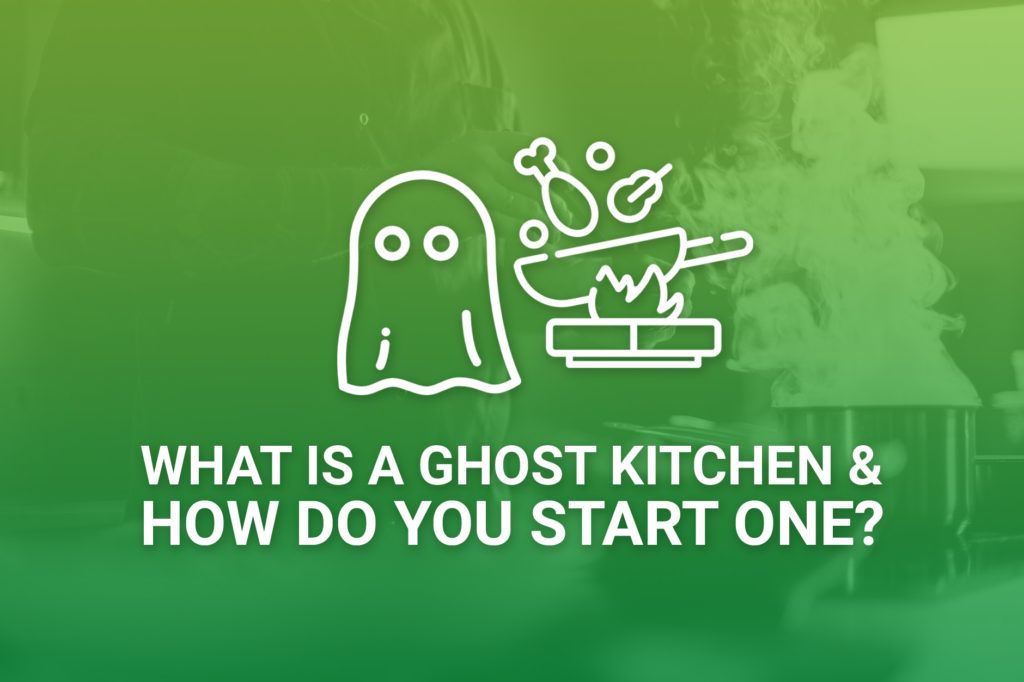Jump to:
- What Is a Ghost Kitchen (Virtual Kitchen)?
- How Does a Ghost Kitchen Work?
- Pros and Cons of Creating a Virtual Kitchen
- How to Set Up and Run a Ghost Kitchen
Throughout the country, ghost kitchens – also known as virtual kitchens – are a relatively new concept growing in popularity. By using a ghost kitchen, a restaurant owner may be able to take advantage of the food delivery market, while simultaneously increasing the utilization of their staff, restaurant space, and supplies.
A ghost kitchen is a restaurant that does not have a physical location that customers can visit. Instead, ghost kitchens can only be reached by ordering online for takeout or delivery. Both existing restaurants and budding restaurateurs can use a ghost kitchen to increase profitability, particularly during the pandemic.
If you are interested in starting a ghost kitchen, read on to learn more about what they are – and whether it makes sense for you to take on this type of project. If you decide to take the plunge, reach out to Budget Branders for custom branded disposable products to help your business increase brand recognition and sales.
What Is a Ghost Kitchen (Virtual Kitchen)?
If you search on Uber Eats, Door Dash, or another food delivery app, you may have noticed something unusual: restaurants that you’ve never heard of offering delivery options. These restaurants are part of a relatively new phenomenon known as ghost kitchens. They have become particularly popular during the COVID-19 pandemic, as many restaurants shift towards takeout, delivery, and online orders.
A ghost kitchen is essentially a restaurant without a brick-and-mortar location that only offers delivery or take-out. Ghost kitchens produce virtual brands, which is exactly what it sounds like: a brand that is only available online or through apps. In other words, it is a restaurant that you can’t visit – but you can order food from online.
A ghost kitchen (or virtual kitchen) can be run in several ways. A restaurant owner may rent a remote space to handle delivery and takeout orders, or they use their own space to run a different restaurant concept – virtually. Alternatively, a skilled home cook or chef without their own restaurant space may rent out space at an existing restaurant to run their ghost kitchen.
For example, in Chicago, Tony Scardino runs Professor Pizza out of the Full Shilling Public House. After helping the owner create a pizza for the restaurant, he asked if he could use its kitchen as a base for his ghost kitchen, Professor Pizza. This arrangement allows him to use an existing kitchen to capitalize on a growing market for takeout and delivery.
Ghost kitchens can be a great way to increase revenue, particularly during the COVID-19 pandemic, where profit margins are tight and restaurants rely more than ever on takeout and delivery. It also allows budding entrepreneurs to get a foot into the restaurant industry, without taking on the expense of opening up their own space to welcome customers.
How Does a Ghost Kitchen Work?
For customers, a ghost kitchen is pretty simple. They can get in touch with the virtual kitchen through its website, a mobile app, or a third party delivery app. There, they can look at the menu, place an order, and then pay for their food. Their order is then delivered to them.
On the restaurant side, once an order is placed, the kitchen staff receives it and begins to prepare the food. Once the food is ready, a delivery driver – either employed by the restaurant or a third party service – takes the order to the customer. The funds are released to the ghost kitchen business once the order is completed.
A ghost kitchen can be set up through a service that rents out kitchen space that complies with local codes, such as Kitchen United or Cloud Kitchen. Alternatively, an existing restaurant can create their own virtual kitchen by renting out space in another area to expand their reach or even by creating a new business within their restaurant to adapt to changing trends and increase revenue.
For example, if your restaurant focuses on homestyle fare, you might offer lighter versions of your recipes – or completely new dishes – through a ghost kitchen. You can do this by creating a name, brand, and website for the virtual kitchen, and then preparing orders for this virtual restaurant through your kitchen. Your staff will just need to keep these orders separate from regular orders – and package them in products that are branded for the ghost kitchen.
Take Boston Market. In cities across the country, it offers both its regular menu and a menu for “Rotisserie Roast,” its ghost kitchen. The menus are very similar, although not identical – and have served as a way for the fast casual restaurant to expand its sales while operating from the same brick-and-mortar locations.
Pros and Cons of Creating a Virtual Kitchen
The online food delivery market is huge – and growing – in the United States. In 2020, the value of this market was $21.2 billion. As the COVID-19 pandemic continues and Americans’ preferences change, the desire for online food delivery is expected to increase.
Given the potential for profit in running a ghost kitchen, it isn’t surprising that a lot of entrepreneurs are considering setting one up for themselves. There are other potential benefits to operating a virtual kitchen, including:
- Minimal overhead to establish a new virtual restaurant;
- Reduced overhead to set up a ghost kitchen in an existing restaurant;
- Ability to meet the ever-growing demand for online delivery;
- Quick start-up;
- The ability to capture a larger audience;
- Reduced dependency on dine-in customers; and
- Streamlined workflows.
However, there are some drawbacks to opening up a ghost kitchen. First, and perhaps most importantly, it can be difficult to ensure that delivery food is of the same quality as what you might serve in a restaurant. Running a virtual kitchen means thinking about the best foods for delivery, packaging the orders properly, and getting everything delivered promptly.
Second, the costs of running a delivery-only business can add up quickly and eat into your profit margin, particularly if you are using a third-party delivery app like DoorDash or Uber. Third, it can be harder to manage customer experience when they never set foot in your restaurant.
Fourth, if you are running a ghost kitchen out of your existing restaurant, it may confuse or even anger customers who think that you are trying to trick them. If you go this route, make sure that you are offering a different experience so that you patrons don’t get upset by thinking that you’re trying to sell them the same food at higher prices.
How to Set Up and Run a Ghost Kitchen
If you decide that the potential risks of running a virtual kitchen are worth the reward of higher sales, then you’ll need to figure out how you can make it happen. Below, we offer a step-by-step guide to running a ghost kitchen that is designed to play to the strengths of virtual restaurants – while minimizing the downsides.
Step 1: Pick a Location
One of the most attractive features of a ghost kitchen is that it can be located almost anywhere. As long as the space is sufficient to be able to receive, cook, and package orders – and it meets local health and safety codes – it will work for a ghost kitchen. This will typically allow you to pay far less than what you would pay for a restaurant space that needs to accommodate dine-in and take-out customers.
Of course, you’ll want to find a space that is centrally located to your anticipated delivery range. If you plan to capitalize on your existing brand, then you may also want to stay within the same general geographic area.
Step 2: Get Necessary Licenses and Permits
Running a ghost kitchen doesn’t mean that you won’t have to comply with local health and safety laws. Depending on where you are located, you may need food handlers permits, an inspection from the Department of Health, a business license, and other permits. Make sure that you comply with all regulations to ensure that you don’t land in legal hot water with your ghost kitchen.
Step 3: Choose Your Menu Carefully
As noted above, a potential drawback of ghost kitchens is that everything is being delivered – and some dishes just don’t travel well. When you set your menu, think about items that will survive delivery and look and taste just as good as they would if you served them in your restaurant. In particular, think about food temperature and texture, and how being packaged and delivered will affect those factors.
Of course, you can also work on packaging that minimizes food quality issues for delivery. However, some foods – like many fried dishes – simply don’t travel well. Keep this in mind as you build your menu.
Step 4: Figure Out Delivery
Ghost kitchens do not offer customers an option to dine in your restaurant. Everything must be delivered, or in some cases, picked up for take-out. Early in the process, you will need to decide how your food will be delivered.
There are two basic options: in-house delivery or delivery via a third-party app like Postmates or Grubhub. If you hire someone to deliver your food, you’ll have a lot more control over when the food goes out and the quality of the delivery service. However, having your own delivery driver is often expensive, as you’ll have to account for things like insurance and payroll costs.
Third-party delivery apps charge a fee for their service, which can often be steep. At the same time, you eliminate a lot of costs when you use a delivery service – like the time and effort of building a website or platform, insurance, and payroll.
Step 5: Set Menu Prices
Based on what type of delivery you choose, you will need to set prices for your menu. While you will likely be saving money on rent and other overhead costs, you’ll also be spending money on having your food delivered. Make sure to factor these expenses in, along with things like your inventory expenses.
Step 6: Hire Staff
When you run a virtual kitchen, you won’t need as many employees as you would with a traditional restaurant. That doesn’t mean that you don’t need any staff at all – you will still need people to receive, cook, and pack your orders. If you are planning to deliver in-house, you’ll also need a delivery driver.
Step 7: Determine and Set Optimal Scheduling
With a ghost kitchen, you can focus our staffing for times when demand is at its highest. This will help to keep labor costs low, and your profit margins high. Make sure to hire enough staff to meet your needs – and to not have more people in your virtual kitchen than you need to get the job done.
Step 8: Market Your Virtual Kitchen
Marketing is critical to the success of any venture – and ghost kitchens are no different. If you want to maximize profits, get to work on promoting it on social media and elsewhere. Make sure that you have claimed your Google Business profile and online restaurant review sites like Yelp. If you collect email addresses with customer orders, use them to market your business even further through email specials and more.
Step 9: Keep a Close Eye on the Numbers
Just like a brick-and-mortar restaurant, the key to success with a ghost kitchen isn’t just having great food – it’s watching your bottom line. At a minimum, you will need to closely track inventory, food waste, sales, and more. Good accounting software can help you automate this process, allowing you to generate reports that give you a snapshot or an in-depth look at how your virtual restaurant is performing.
Step 10: Get Creative
It can be hard to experiment with your menu when you have an established brand, because customers have certain expectations of your restaurant. With a virtual kitchen, you can play around a bit – after all, your menu only exists online. You might choose to add a mid-day special based on what looks good at the market, remove items because they aren’t selling well, or just let your chef come up with something completely new to wow customers.
Boost Your Ghost Kitchen’s Visibility with Custom Disposables
One of the challenges facing many ghost kitchens is that customers typically don’t recognize them in the same way that they acknowledge established restaurants. One way to build your ghost kitchen’s brand is by using custom disposables. After all, your customers won’t be walking into a physical restaurant – but they will remember the paper bag, cups, or other branded items that you used for their food and beverages.
At Budget Branders, we offer a full range of custom disposable products for restaurants, bars, coffee shops – and ghost kitchens. Our products are available in prices and quantities that make sense for small and medium-sized businesses. If you’re interested in learning more or would like a quote for products for your virtual restaurant, contact us at 888-373-4880, press the live chat button, or fill out our online contact form.





















